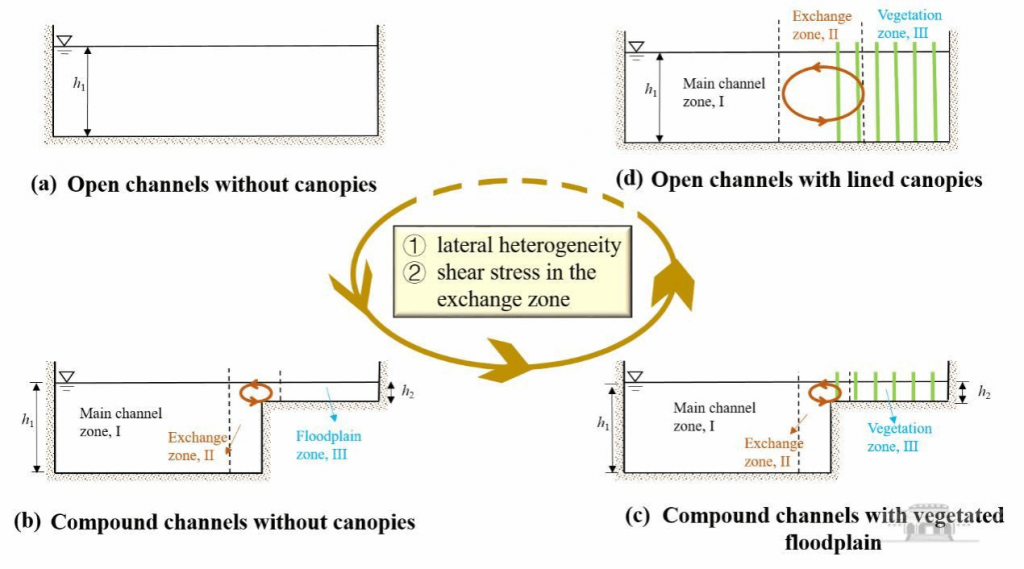水资源工程与调度全国重点实验室、水利水电教授槐文信教授应Journal of Hydrodynamics主编邀请,撰文探讨植被化生态河道的纵向离散系数研究进展及挑战。该文章得到主编高度认可,特选为期刊35卷第3期封面文章,在刊物封面重点介绍和推荐阅读。
论文题为Longitudinal dispersive coefficientin channels withaquatic vegetation: A review(《含水生植被河道的纵向离散系数:综述》),课题组博士后杨柳、博士研究生方皓泽,实验室杨中华教授为论文共同作者,槐文信为通讯作者。


水生植被作为生态河道建设的主要内容之一,对河道污染物扩散效率的影响显著,离散系数是综合反映河道内溶质扩散强度的重要参数指标之一。作为一篇系统性阐述和介绍离散过程的综述性文章,槐文信教授从离散系数的基本定义出发,系统梳理了离散系数的基本概念,在全面介绍该研究发展历史和国内外研究现状的同时,深入浅出地阐述了影响离散强度的关键因素,将其在此领域多年耕耘的深刻认识和成果转化成简洁、系统、准确的综述,助力生态环境水力学理论发展。
受河道床面形态、植被生长聚集模式、以及水流条件等参数的耦合作用,植被化河道离散系数求解困难一直是限制生态河道建设和生态修复技术实施的难题之一,也是当前众多学者重点关注和研究的热点问题之一。槐文信教授根据不同河道形态和植被分布特征,将离散强度变化的诱因分为两类,即横向和垂向流场空间不均匀。河道断面形态发生变化时(如图2),流场的横向空间不均匀强度是离散系数的主导因素,同时,河道主槽和边滩的水流结构以及两个区域之间的动量交换强度对溶质输移的作用显著。文章深入探讨了不同河道断面形态下,边滩植被特征(如:密度和聚集模式)及边滩“深度比”对离散强度的作用效应。
对于水生植被生长覆盖整个河道断面的情况,流场垂向的空间不均匀作用效应超越了空间横向变化作用,是主导河道离散强度大小的关键水力因素。图3所示为三种典型的水生植被生长模式及流速分布规律,植被生长模式直接影响流速分布规律,发挥着控制离散系数变化的作用。基于对流场速度、紊流涡结构以及各区之间的动量交换强度进行综合分析,文章总结了不同情况的离散作用特征及研究现状,并提出当前研究亟待解决的问题和面临的挑战。

对于水生植被生长覆盖整个河道断面的情况,流场垂向的空间不均匀作用效应超越了空间横向变化作用,是主导河道离散强度大小的关键水力因素。图3所示为三种典型的水生植被生长模式及流速分布规律,植被生长模式直接影响流速分布规律,发挥着控制离散系数变化的作用。基于对流场速度、紊流涡结构以及各区之间的动量交换强度进行综合分析,文章总结了不同情况的离散作用特征及研究现状,并提出当前研究亟待解决的问题和面临的挑战。

作者介绍

槐文信
武汉大学水利水电学院二级教授,博士生导师,珞珈杰出学者,1996年入选国家有突出贡献中青年专家,享受国务院政府特殊津贴。担任三本国际期刊副主编 Journal of Hydrodynamics, Journal of Hydro-environment Research, Energy, Ecology and Environment,及《水利学报》、《武汉大学学报》等期刊编委。主要从事生态环境水力学研究,在含植物河道环境水力学和水沙动力学基础理论研究与河道生态修复水力调控应用研究等方面取得系统性研究成果。
主持13项国家自然科学基金和2项国家水体污染控制与治理科技重大项目专题,发表论文论著378篇(部),其中 SCI 收录168篇, EI 收录222篇,著作教材8部, Google 学术数据库总被引5000余次;2022年入选全球前2%顶尖科学家“科学影响力排行榜”;获2项国家级和12项省部级科技奖及周培源水动力学一等奖。







